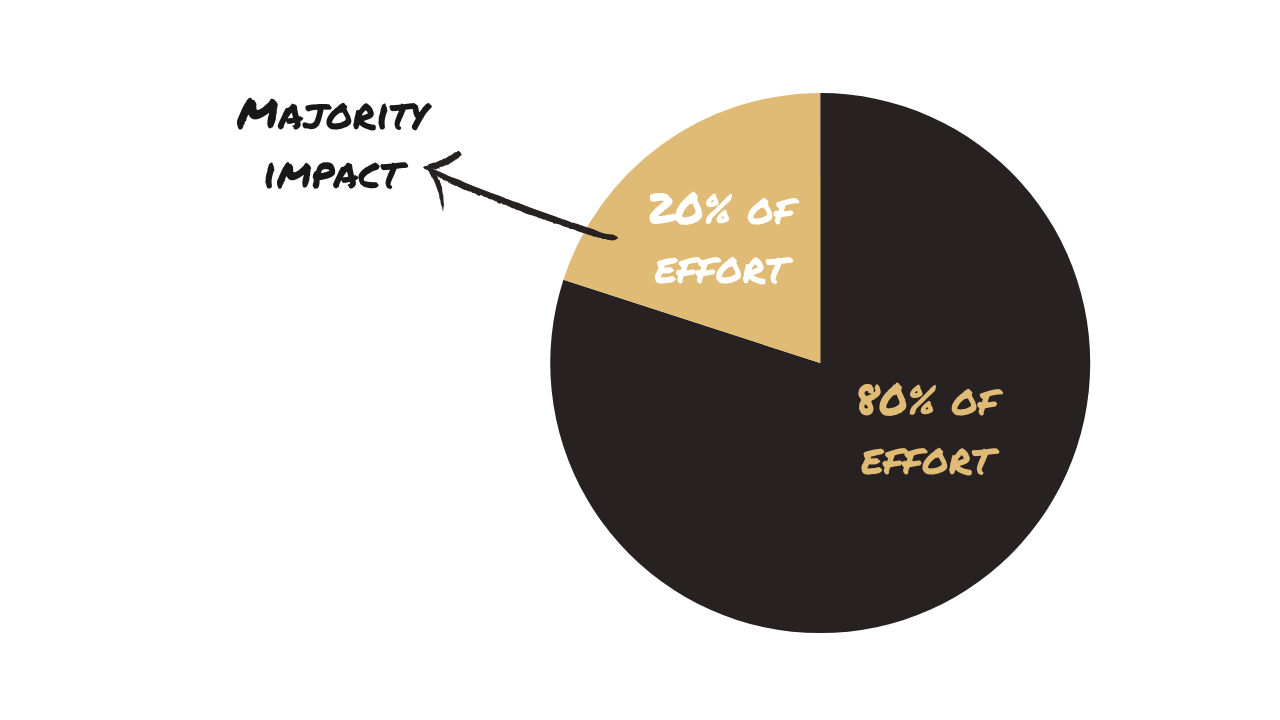What is the Pareto Principle?
The Pareto Principle, also known as the 80/20 rule, states that 80% of outcomes often come from just 20% of efforts. Italian economist Vilfredo Pareto discovered this while observing that 80% of Italy's land was owned by 20% of its population. Over time, this idea has been applied to nearly every area of life, from business to personal development.
Simply put, not all efforts yield the same results. Some things you do will have a far greater impact than others. The key is figuring out what those high-leverage actions are that will give you the most output for the time and energy you input.
Why the Pareto Principle Matters. Real World Examples.
The Pareto Principle is everywhere. Take a second to think about your wardrobe: you probably wear 20% of your clothes 80% of the time. Or take your workday, where 20% of your tasks likely produce 80% of your results.
Here are three real-world examples of the Pareto Principle in action:
- Work Productivity: Think about your workday. If you reflect on your to-do list, you’ll likely realize a small fraction of tasks generate the bulk of your accomplishments. Those are the high-leverage activities worth your focus.
- Relationships: In your social circle, you probably get the most joy and support from a handful of meaningful connections. It’s as simple as asking whether you’d spend your precious time with hundreds of acquaintances, or five deep friendships. Pouring energy into these key relationships will probably outweigh spreading yourself thin.
- Health and Fitness: In wellness, focusing on a few core habits like regular exercise, balanced eating, and good sleep, has a more significant impact on your health than any fad diet or supplement ever could.
Understanding this principle is crucial because it underscores where your energy and focus should go. Without this awareness, you risk spending too much time on low-impact activities, which can leave you feeling drained and without much to show for it.
Using High-Leverage Tasks to Your Advantage

Here’s the cool thing about the Pareto Principle: it teaches you to focus on what truly matters, which requires self-awareness. You have to pause and ask yourself: “What activities are driving the biggest results in my life?”
Let’s say someone is incredibly successful at work, pouring all their energy into their career. They work long hours, take on every project, and climb the corporate ladder. But they neglect their health by eating poorly, barely sleeping, and rarely exercising. Maybe they are unaware of the bigger picture and unintentionally making the trade-off of their health for career success.
Eventually, this catches up with them. Their health deteriorates, which impacts their productivity, relationships, and quality of life. The irony? Taking better care of their health—the 20% effort—could have sustained their career success—the 80% result.
In this mini story, this is where self-awareness comes into play. When you take the time to reflect on your life, you can identify the areas where your effort isn’t aligned with your values or long-term goals. By recognizing when you’re over-investing in areas that don’t serve your overall well-being, it enables you to shift your focus to the factors that have the most significant impact on your life.
Misinterpretations of the Pareto Principle
Now before we dive into how to apply the 80/20 Rule, let’s clear up some common misinterpretations that can derail its effectiveness:
“It’s Always Exactly 80/20”.
Some people assume the ratio must always be 80/20. Yet the truth is, it’s not a rigid rule. The ratio could be 90/10, 70/30, or any other disproportionate split. The point is recognizing that a minority of inputs often generates the majority of results.
“The 20% Is Easy to Identify”.
It might sound simple to find the high-impact 20%, but it’s not always obvious. Identifying it requires reflection, data, and sometimes trial and error. What’s working might not be immediately apparent, and it can take some self-reflection to uncover these insights.
“It Applies Everywhere, Without Exception”.
While the Pareto Principle shows up in many scenarios, it’s not universal. Overgeneralizing it can lead to poor decisions. For example, some creative or interpersonal contexts might not follow this pattern as clearly.
How to Apply the 80/20 Rule
If you’re ready to harness the Pareto Principle, here are some practical steps to start integrating it into your everyday living:
2. Audit your efforts: Look at how you’re spending your time and energy. Are you focused on high-impact activities, or are you getting bogged down by things that don’t move the needle?
3. Focus on the 20%: Once you’ve identified the actions that drive the most results, double down on them. This could be at work, prioritizing tasks that directly contribute to your goals, or in your personal life, investing in relationships that bring you joy and support.
4. Let go of the 80%: This can be tough, but it’s necessary. Say no to distractions, delegate when possible, and eliminate habits that don’t serve you.
5. Check in regularly: Self-awareness is an ongoing process. Make it a habit to reflect on what’s working and where adjustments are needed.
1. Identify your priorities: Take stock of your life, such as your work, relationships, health, personal growth. What areas truly matter to you?
2. Audit your efforts: Look at how you’re spending your time and energy. Are you focused on high-impact activities, or are you getting bogged down by things that don’t move the needle?
3. Focus on the 20%: Once you’ve identified the actions that drive the most results, double down on them. This could be at work, prioritizing tasks that directly contribute to your goals, or in your personal life, investing in relationships that bring you joy and support.
4. Let go of the 80%: This can be tough, but it’s necessary. Say no to distractions, delegate when possible, and eliminate habits that don’t serve you.
5. Check in regularly: Self-awareness is an ongoing process. Make it a habit to reflect on what’s working and where adjustments are needed.
Summing it All Up…
The Pareto Principle isn’t just a productivity hack—it’s a mental model that can help you create a more intentional, balanced life. When paired with self-awareness, it empowers you to focus on what truly matters and let go of what doesn’t.
So, ask yourself: Where are you spending your time and energy? Are you focusing on the 20% that creates 80% of the impact, or are you stuck in the weeds?
The choice is yours. By aligning your efforts with what’s most important, you’ll improve the decisions you make on a daily basis by identifying and focusing on your 20%.
Sincerely,
Sincerely,
Dexter Lam
Mental Models
Want to explore more mindset frameworks for optimizing your decision-making?

Do you want to level up and change your life Trajectory?
We're launching our course on Self-Awareness
Thank you!

